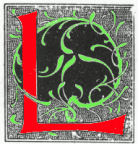
ike the stories they illustrate, Victorian fairy-tale illustrations tend to fall in one of two general categories: the sentimental and the fantastic. Most of them depict children, animals, and fantastic beings surrounded by various forms of vegetation within a larger landscape. There is a grace and fluidity of line in all the illustrations, sometimes conveyed with a hurried cartoon-like dash, but often with a tremendous eye for detail. The illustrators carefully include as much detail as possible from the moment of the tale they are depicting . In so doing, they demonstrate a Victorian fascination with the alternate worlds depicted in fairy tales.
The tremendous breadth of Victorian fairy tales and their illustrations influence the format of this project in several ways. I have chosen to highlight a few illustrators with distinctive styles, as well as to give examples of the great generic diversity. Thus, some images will appear more than once in the presentation as necessary.

Some of these alternate worlds look surprisingly like our own, for many (if not most) Victorian fairy tales take place in contemporary England or a in nearby nation and portray typical representatives of the various social classes living their lives as usual until they unexpectedly encounter a foreign person, being, or situation. For example, "Jack's New Friend" from Jean Ingelow's tale, "Mopsa the Fairy" (1869), depicts a boy enountering a strange woman in a secluded field. Note how the artist (identified merely as "JM") manipulates the medium of engraving to make subtle contrasts of light and shade, thus adding to the life-like qualities of the scene. Also note the expression on Jack's face and the careful demarkation of his toes. [Click on the illustration for a full-size illustration, which will take some time to download.

"Jack Listening to the Perch's Story" (click on this detail for the full picture) takes place in a realistically depicted but fantastic setting -- under water. This illustration comes from Fanny Lablache's tale "Jack with the Fishes" from Starlight Stories (1884). The artist is Kate Greenaway, one of only a handful of woman illustrators I have encountered in fairy tale illustration. Note how Jack seems indifferent to the fish who are speaking (!) to him --- he does not even make eye-contact with them. Also note Jack's appropriate little boy costume and wavy hair.
Both these two images draw on the author's use of nostalgia to create a familiar atmosphere in which to introduce the unfamiliar. The visual presentation of a "safe space" often involves framing the action with life-like vegetaion and closing in the surrounding landscape as in the images above -- something seen in George Cruikshank's an illustration for Henry and Augustus Mayhew'sGood Genius.

Many illustrations, which contain nothing particularly unusual, make particular use of the facial expressions and gestures. For example, in the frontespiece for Lablache's Starlight Stories, which depicts the climax of "Ruli's Sacrifice," Greenaway heightens the emotional impact of an otherwise fairly banal image with strong contrasts of light and shadow and with and a sequence of repeated curved shapes (the chair back, Ruli's arm, the arches in the background) that pull the viewer's attention to the lowered position of Ruli's head.
A final observation: most illustrations only depict one individual encountering another. There is an intimate connection between the protagonist of the tale, the author, the artist, and the reader. Also, note the extent to which the personification of animals figures in the sentimentality of the images.
A note on the identity of the illustrator “JM”
Liselot Quisquater wrote in December 2015: “Some scholars even seem to attribute the drawings to John Millais (such as Elaine Ostry in her article "Magical Growth and Moral Lessons; or, How the Conduct Book Informed Victorian and Edwardian Children" and so does Alison Chapman in a chapter on "Phantasies of Matriarchy in Victorian Children's Literature"). I am not quite sure whether these attributions are correct, however, because I cannot find any more information about the illustrations for Mopsa the Fairy, nor do I come across any other information about John Millais's possible work for this particular story of Jean Ingelow's. Moreover, Millais's usual initial-signature was quite different from these initials, so I doubt that he was the artist.”
Related material
Created 2000; note added 25 December 2015